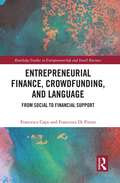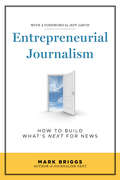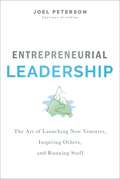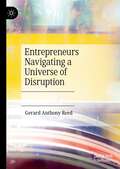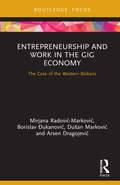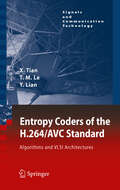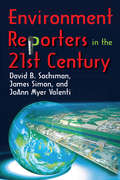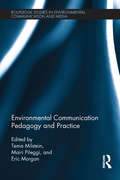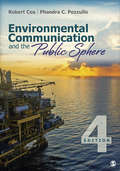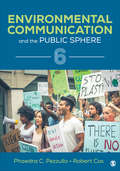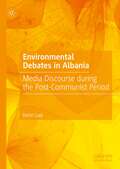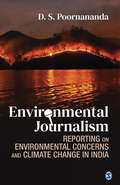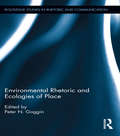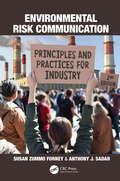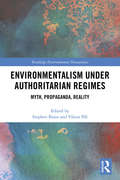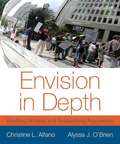- Table View
- List View
EntreCulturas 1: Communicate, Explore, and Connect Across Cultures
by Robert Davis Ann Mar Maritza Sloan George Watson-LopezEntreCulturas 1: Communicate, Explore, and Connect Across Cultures is the first book in a ground-breaking Spanish language and culture textbook series. EntreCulturas 1 is designed for novice Spanish learners in middle or high school. In this level, students build the language skills, the personal attitudes, and the cultural insights necessary to experience life entre culturas, using Spanish to connect with people. There are seven units in EntreCulturas 1, an introductory unit and six additional units. The units in level one may be divided for use over two years of middle school instruction.
Entrepreneurial Finance, Crowdfunding, and Language: From Social to Financial Support (Routledge Studies in Entrepreneurship and Small Business)
by Francesca Di Pietro Francesca CapoConsidering language a relevant strategic instrument that entrepreneurs and managers can use to seek external resources, this book investigates and discusses whether and under which conditions language strategies can facilitate entrepreneurs’ social support and legitimation as well as access to external resources. This book systematically integrates language into the entrepreneurial finance literature and develops a new and more comprehensive framework that relates crowdfunding to language strategies. Therefore, readers will comprehend how language choices, frames and narratives influence companies’ ability to secure social and financial support, and therefore sustain the development of their venture. Overall, this book provides insights into how entrepreneurs can use language as a strategic tool for accessing resources and support from external stakeholders, thereby considering, alongside traditional economic approaches, institutional processes of meaning-making.
Entrepreneurial Finance, Crowdfunding, and Language: From Social to Financial Support (Routledge Studies in Entrepreneurship and Small Business)
by Francesca Di Pietro Francesca CapoConsidering language a relevant strategic instrument that entrepreneurs and managers can use to seek external resources, this book investigates and discusses whether and under which conditions language strategies can facilitate entrepreneurs’ social support and legitimation as well as access to external resources.This book systematically integrates language into the entrepreneurial finance literature and develops a new and more comprehensive framework that relates crowdfunding to language strategies. Therefore, readers will comprehend how language choices, frames and narratives influence companies’ ability to secure social and financial support, and therefore sustain the development of their venture.Overall, this book provides insights into how entrepreneurs can use language as a strategic tool for accessing resources and support from external stakeholders, thereby considering, alongside traditional economic approaches, institutional processes of meaning-making.
Entrepreneurial Identity in US Book Publishing in the Twenty-First Century (Elements in Publishing and Book Culture)
by Rachel NoordaEntrepreneurship underpins many roles within the publishing industry, from freelancing to bookselling. Entrepreneurs are shaped by the contexts in which their entrepreneurship is situated (social, political, economic, and national). Additionally, entrepreneurship is integral to occupational identity for book publishing entrepreneurs. This Element examines entrepreneurship through the lens of identity and narrative based on interview data with book publishing entrepreneurs in the US Book publishing entrepreneurship narratives of independence, culture over commerce, accidental profession, place, risk, (in)stability, busyness, and freedom are examined in this Element.
Entrepreneurial Journalism: How to Build What's Next for News
by Mark E. BriggsEntrepreneurial Journalism will inspire you with what's possible and show you the mechanics behind building a business. Working through eight clear and concise stages, you'll explore the secrets of successful news startups (including how they're making money) and learn how to be an upstart yourself, building an innovative and sustainable news business from scratch. Each chapter starts with a real entrepreneur's experience, teasing out how savvy and opportunistic journalists found their way to success. Mark Briggs then helps you size up the market, harness technology, turn your idea into a product or service, explore revenue streams, estimate costs, and launch. "Build Your Business" action items at the end of each chapter get you thinking through each step of your business plan.
Entrepreneurial Leadership: The Art of Launching New Ventures, Inspiring Others, and Running Stuff
by Joel PetersonMake a lasting impact by launching new initiatives, inspiring others, and championing innovative approaches with this from-the-trenches guide by trusted executive mentor, entrepreneur, and leadership expert Joel Peterson. Many leaders see their roles as presiders/managers, with a primary focus on keeping results consistent with past performance and on budget. These kinds of leaders make important contributions but rarely leave a mark on the businesses they serve. For those wanting to make a lasting impact, new skills are required. They need to learn to launch new initiatives, inspire others, and champion innovative approaches. Joel Peterson calls these higher-level leaders &“entrepreneurial leaders,&” and they create durable enterprises that deliver on their promise.After three careers, four decades of marriage and seven kids, and demanding roles as CFO, CEO, chairman, lead director, adjunct professor, founder, author, entrepreneur and investor, Joel Peterson is often sought as a mentor and coach by leaders and aspiring leaders. He has worked with all types of leaders and considers the entrepreneurial leader to be the highest level of influence.Peterson lays out a path to achieving this summit, with a series of leadership maps organized around the four essential basecamps on the path to Entrepreneurial Leadership:Establishing TrustCreating a Sense of MissionBuilding a Cohesive TeamExecuting and Delivering ResultsThese core philosophies, while easy to summarize, can be extremely difficult to implement. As Peterson says:&“This book of maps and mindsets is aimed at those who hope to lead others, help them achieve their best, break new barriers, change the status quo, create a legacy, develop a brand, and enjoy a life-altering experience.&”Let Entrepreneurial Leadership guide you on your journey.
Entrepreneurs Navigating a Universe of Disruption
by Gerard Anthony ReedThis book details the exploratory stages of a research study that produced a framework for entrepreneurial endeavour and enterprise. It presents an unfolding discussion, throughout its chapters, regarding the entrepreneurial nature potential within us all, and the modes by which those involved in such activity, and associated innovative discoveries, can be informed by the skills and experience already in their possession.The book also provides, through its structure, a tool by which the entrepreneur, innovator, educator, student or those yet-to-be involved in the entrepreneurial arena can plan for the yet-to-be known eventualities of such endeavour.The parabolic scramble framework is backgrounded across the discussion of entrepreneurship and the necessity to deal with the tangible and intangibility of any venture, as well as other considered aspects that the entrepreneurial journey engenders.
Entrepreneurship and Work in the Gig Economy: The Case of the Western Balkans (Routledge Focus on Business and Management)
by Mirjana Radović – Marković Borislav Đukanović Dušan Marković Arsen DragojevićThe crisis caused by COVID-19 poses a major challenge for the global economy and business. It has been a test for economic resilience, and how this crisis will affect business activities will be determined by their competitiveness. Only firms that have succeeded in reorienting and quickly adapting to the emerging crisis have continued without interruption in their operations, thus demonstrating their flexibility and high level of resilience. Research shows that companies driving the gig economy celebrate the benefits: flexibility, additional income, freedom and other various opportunities for workers. They require entrepreneurial digital skills that improve their competitiveness and benefit not only themselves but the economy as well. Therefore, digital competencies are becoming a significant resource and precondition for employment, and it is essential to promote digital entrepreneurial skills, introducing them into education programs through different forms of education. This book stresses and explores the importance of synergy between industry and virtual universities. Considering the importance of these issues, this book draws together literature on globalization and small and medium enterprise development and internationalization from disparate sources into a cohesive body of work, which traces the evolution of entrepreneurship and our understanding of the topic. It investigates the impact of digitalization on creating job opportunities in the labor market. Covering social, economic and psychological approaches to the most current topics, this book will be a useful framework to new theories and practices that are emerging to challenge conventional wisdom. It will be of interest to scholars, upper-level students, and researchers involved in the field of entrepreneurship.
Entropy Coders of the H.264/AVC Standard
by Thinh M. Le Xiaohua Tian Yong LianThis book presents a collection of algorithms and VLSI architectures of entropy (or statistical) codecs of recent video compression standards, with focus on the H.264/AVC standard. For any visual data compression scheme, there exists a combination of two, or all of the following three stages: spatial, temporal, and statistical compression. General readers are first introduced with the various algorithms of the statistical coders. The VLSI implementations are also reviewed and discussed. Readers with limited hardware design background are also introduced with a design methodology starting from performance-complexity analyses to software/hardware co-simulation. A typical design of the Contextbased Adaptive Binary Arithmetic Coding (CABAC) encoder is also presented in details. To support System-on-Chip design environment, the CABAC design is wrapped with a SoC-based Wishbone system bus interface.
Environment Reporters in the 21st Century
by JoAnn Myer ValentiEnvironment Reporters in the 21st Century is the story of a relatively new journalistic beat, environmental reporting. This book explores the development of the environmental beat as a specialty during the last thirty years. It also discusses broader trends within American journalism resulting from technological changes that challenge traditional mediums, especially newspapers and magazines.The book is divided into three parts. The first reviews the literature and explains the methodology. The second describes the results of the authors' research. The third provides in-depth accounts of environment reporters at work. A final chapter puts the research in historical perspective, viewing it in terms of the economic decline of the newspaper business and of local television news.Journalists mediate a constant struggle among thousands of environmental activists, corporate public relations people, government officials, and scientists to shape environmental reporting. This volume tells the story of environmental reporting imaginatively and innovatively.
Environmental Communication Pedagogy and Practice (Routledge Studies in Environmental Communication and Media)
by Tema Milstein Mairi Pileggi Eric L MorganGiven the urgency of environmental problems, how we communicate about our ecological relations is crucial. Environmental Communication Pedagogy and Practice is concerned with ways to help learners effectively navigate and consciously contribute to the communication shaping our environmental present and future. The book brings together international educators working from a variety of perspectives to engage both theory and application. Contributors address how pedagogy can stimulate ecological wakefulness, support diverse and praxis-based ways of learning, and nurture environmental change agents. Additionally, the volume responds to a practical need to increase teaching effectiveness of environmental communication across disciplines by offering a repertoire of useful learning activities and assignments. Altogether, it provides an impetus for reflection upon and enhancement of our own practice as environmental educators, practitioners, and students. Environmental Communication Pedagogy and Practice is an essential resource for those working in environmental communication, environmental and sustainability studies, environmental journalism, environmental planning and management, environmental sciences, media studies and cultural studies, as well as communication subfields such as rhetoric, conflict and mediation, and intercultural. The volume is also a valuable resource for environmental communication professionals working with communities and governmental and non-governmental environmental organisations.
Environmental Communication and the Public Sphere
by J. Robert Cox Dr Phaedra C. PezzulloThe Fourth Edition of Environmental Communication and the Public Sphere remains the only comprehensive introduction to the growing field of environmental communication, ranging from an historical overview of key terms to important legal and technological developments. This innovative book focuses on how human communication influences the way we perceive and act in the environment. It also examines how we interpret environmental “problems” and decide what actions to take with regard to the natural world. Three-time president of the Sierra Club, the largest environmental group in the United States, lead author Robert Cox leverages his vast experience to offer insights into the news media, Congress, environmental conflict, advocacy campaigns, and other real-world applications of environmental communication. New coauthor Phaedra Pezzullo brings two decades of applied experience working with grassroots environmental justice and health organizations, citizen advisory boards, and student-led campaigns, as well as her internationally recognized research on toxic pollution, social injustices, public advocacy, and more. The authors introduce the reader to the major areas, terms, and debates of this evolving field. The Fourth Edition incorporates major revisions that include four new chapters on visual and popular culture, digital media and activism, the sustainability of college and corporation campuses, and the legal “standing” of citizens and nature. Updates throughout the text draw on timely topics including visual communication used in climate science campaigns, fracking and challenges to the right to know, plastic bag bans, consumer apps, digital activism for environmental justice, green marketing, and arguments on giving legal rights to nonhuman entities from dolphins to rivers.
Environmental Communication and the Public Sphere
by Robert Cox Phaedra C. PezzulloThe best-selling Environmental Communication and the Public Sphere provides a comprehensive introduction to the growing field of environmental communication. This groundbreaking book focuses on the role that human communication plays in influencing the ways we perceive the environment. Authors Phaedra C. Pezzullo and Robert Cox examine how we define what constitutes an environmental problem and how we decide what actions to take concerning the natural world. The Sixth Edition explores recent events and research, including fast fashion, global youth climate strikes, biodiversity loss, disability rights advocacy, single-use plastic ban controversies, and the COVID-19 pandemic.
Environmental Communication and the Public Sphere
by Robert Cox Phaedra C. PezzulloThe best-selling Environmental Communication and the Public Sphere provides a comprehensive introduction to the growing field of environmental communication. This groundbreaking book focuses on the role that human communication plays in influencing the ways we perceive the environment. Authors Phaedra C. Pezzullo and Robert Cox examine how we define what constitutes an environmental problem and how we decide what actions to take concerning the natural world. The Sixth Edition explores recent events and research, including fast fashion, global youth climate strikes, biodiversity loss, disability rights advocacy, single-use plastic ban controversies, and the COVID-19 pandemic.
Environmental Communication and the Public Sphere: Cox: Environmental Communication And The Public Sphere 4e + Clarke: Environmental Communication Management
by Dr Phaedra C. Pezzullo Robert CoxThe Fifth Edition of the award-winning Environmental Communication and the Public Sphere is the first comprehensive introduction to the growing field of environmental communication. This groundbreaking book focuses on the role that human communication plays in influencing the ways we perceive the environment. It also examines how we define what constitutes an environmental problem and how we decide what actions to take concerning the natural world. The updated and revised Fifth Edition includes recent developments, such as water protectors and the Dakota Access Pipeline, the Flint Water Crisis, and the March for Science, along with the latest research and developments in environmental communication.
Environmental Communication and the Public Sphere: Cox: Environmental Communication And The Public Sphere 4e + Clarke: Environmental Communication Management
by Dr Phaedra C. Pezzullo Robert CoxThe Fifth Edition of the award-winning Environmental Communication and the Public Sphere is the first comprehensive introduction to the growing field of environmental communication. This groundbreaking book focuses on the role that human communication plays in influencing the ways we perceive the environment. It also examines how we define what constitutes an environmental problem and how we decide what actions to take concerning the natural world. The updated and revised Fifth Edition includes recent developments, such as water protectors and the Dakota Access Pipeline, the Flint Water Crisis, and the March for Science, along with the latest research and developments in environmental communication.
Environmental Communication. Second Edition: Skills and Principles for Natural Resource Managers, Scientists, and Engineers.
by Richard R. Jurin K. Jeffrey Danter Donny RoushEnvironmental professionals can no longer simply publish research in technical journals. Informing the public is now a critical part of the job. Environmental Communication demonstrates, step by step, how it's done, and is an essential guide for communicating complex information to groups not familiar with scientific material. It addresses the entire communications process, from message planning, audience analysis and media relations to public speaking - skills a good communicator must master for effective public dialogue. Environmental Communication provides all the knowledge and tools you need to reach your target audience in a persuasive and highly professional manner. "This book will certainly help produce the skills for environmental communications sorely needed for industry, government and non-profit groups as well as an informed public". Sol P. Baltimore, Director, Environmental Communications and Adjunct faculty, Hazardous Waste management program, Department of Chemical Engineering, College of Engineering, Wayne State University, Detroit, Michigan. "All environmental education professionals agree that the practice of good communications is essential for the success of any program. This book provides practical skills for this concern". Ju Chou, Associate Professor, Graduate Institute of Environmental Education National Taiwan Normal University Taipei, Taiwan
Environmental Conflict Management
by Tarla Rai Peterson Tracy Lee ClarkeA step-by-step guide connecting theory to practice Environmental Conflict Management introduces students to the research and practice of environmental conflict and provides a step-by-step process for engaging stakeholders and other interested parties in the management of environmental disputes. In each chapter, authors Dr. Tracylee Clarke and Dr. Tarla Rai Peterson first introduce a specific concept or process step and then provide exercises, worksheets, role-plays, and brief case studies so students can directly apply what they are learning. The appendix includes six additional extended case studies for further analysis. In addition to providing practical steps for understanding and managing conflict, the text identifies the most relevant laws and policies to help students make more informed decisions. Students will develop techniques for public involvement and community outreach, strategies for effective meeting management, approaches to negotiating options and methodologies for communicating concerns and working through differences, and outlines for implementing and evaluating strategies for sustaining positive community relations.
Environmental Conflict Management
by Tarla Rai Peterson Tracy Lee ClarkeA step-by-step guide connecting theory to practice Environmental Conflict Management introduces students to the research and practice of environmental conflict and provides a step-by-step process for engaging stakeholders and other interested parties in the management of environmental disputes. In each chapter, authors Dr. Tracylee Clarke and Dr. Tarla Rai Peterson first introduce a specific concept or process step and then provide exercises, worksheets, role-plays, and brief case studies so students can directly apply what they are learning. The appendix includes six additional extended case studies for further analysis. In addition to providing practical steps for understanding and managing conflict, the text identifies the most relevant laws and policies to help students make more informed decisions. Students will develop techniques for public involvement and community outreach, strategies for effective meeting management, approaches to negotiating options and methodologies for communicating concerns and working through differences, and outlines for implementing and evaluating strategies for sustaining positive community relations.
Environmental Debates in Albania: Media Discourse during the Post-Communist Period
by Deniz ÇupiThis book investigates the role played by classical and digital media, and social networks in shaping debates on the environment. Providing a unique window of observation on environmental debates, the book explores the media theatre from the post-communist perspective of Albania. The work navigates the creation and development of environmental debate in Albania using evidence-based case studies, investigating the role of actors involved, who are closely related to the media, such as in business or politics. Environmental Debates in Albania offers an original insight on environmental debate, which is closely tied to and influenced by the place and culture within which it originates. Rich literature exists on global environmental issues, protests, policy and the rhetoric around climate change; this book supplies another piece to the puzzle through its focus on the under-researched area of environmental debate in post-communist and Eastern European countries.
Environmental Journalism: Reporting on Environmental Concerns and Climate Change in India
by D. S. PoornanandaEnvironmental Journalism: Reporting on Environmental Concerns and Climate Change in India examines the increase of environmental concerns and its reflection in Indian media, exploring the possibilities of and constraints in covering environmental news. The book discusses major challenges in environmental reportage, such as political and corporate pressures on media houses and threats to journalists. It discusses why environmental reporting is not considered an important ‘beat’ and reports covering these issues are usually assigned to junior reporters. This book analyses why journalists lack the proper training to report on environmental issues, focusing on the many obstacles to scientific knowledge and specialized training. It draws critical insights from interviews with environmental journalists, activists and specialists, and will be an important read for scholars of not only media studies and environmental studies but also sociology, politics and development studies. Looking at the media’s role in framing environmental degradation as a human rights issue, the book argues that the growth of environmental journalism can contribute significantly to global initiatives for saving the planet.
Environmental Rhetoric and Ecologies of Place (Routledge Studies in Rhetoric and Communication)
by Peter N. GogginUnderstanding how rhetoric, and environmental rhetoric in particular, informs and is informed by local and global ecologies contributes to our conversations about sustainability and resilience — the preservation and conservation of the earth and the future of human society. This book explores some of the complex relationships, collaborations, compromises, and contradictions between human endeavor and situated discourses, identities and landscapes, social justice and natural resources, movement and geographies, unpacking and grappling with the complexities of rhetoric of presence. Making a significant contribution to exploring the complex discursive constructions of environmental rhetorics and place-based rhetorics, this collection considers discourses, actions, and adaptations concerning environmental regulations and development, sustainability, exploitation, and conservation of energy resources. Essays visit arguments on cultural values, social justice, environmental advocacy, and identity as political constructions of rhetorical place and space. Rural and urban case studies contribute to discussions of the ethics and identities of environment, and the rhetorics of environmental cartography and glocalization. Contributors represent a range of specialization across a variety of scholarly research in such fields as communication studies, rhetorical theory, social/cultural geography, technical/professional communication, cartography, anthropology, linguistics, comparative literature/ecocriticism, literacy studies, digital rhetoric/media studies, and discourse analysis. Thus, this book goes beyond the assumption that rhetorics are situated, and challenges us to consider not only how and why they are situated, but what we mean when we theorize notions of situated, place-based rhetorics.
Environmental Risk Communication: Principles and Practices for Industry
by Susan Zummo Forney Anthony J. SadarModern industry faces many communication challenges, including social media. The second edition of this book is thoroughly updated, expanded, and reorganized to help industry communicators remain effective in addressing these challenges. At the core of this book are foundational building blocks that address the human factors responsible for driving success or failure when communicating about environmental risk. Features Provides principled guidance for building relationships and engaging in constructive dialogue with stakeholders. Offers straight talk and practical, easy-to-follow guidance on effective risk communication for various situations, stakeholders, and modes of communication. Gives lessons learned from environmental permitting and crisis situations involving risk communication in various industries, including chemical manufacturing, waste management, and the energy sector. Addresses nuanced, recent concerns regarding issues like fake news and social media bullying. Examines the dos and don’ts of communicating effectively during tough conditions like environmental emergencies. Environmental Risk Communication: Principles and Practices for Industry is intended to be both a grounding in enduring principles and a continued resource for best approaches and techniques. Coupled with tools and best practices from decades of experience, this insider’s guide provides CEOs, plant managers, environmental compliance professionals, health and safety officers, and others with the direction and the confidence needed to prepare for difficult dialogue and high-pressure encounters.
Environmentalism under Authoritarian Regimes: Myth, Propaganda, Reality (Routledge Environmental Humanities)
by Viktor Pál Stephen BrainSince the early 2000s, authoritarianism has risen as an increasingly powerful global phenomenon. This shift has not only social and political implications, but also environmental implications: authoritarian leaders seek to recast the relationship between society and the government in every aspect of public life, including environmental policy. When historians of technology or the environment have investigated the environmental consequences of authoritarian regimes, they have frequently argued that authoritarian regimes have been unable to produce positive environmental results or adjust successfully to global structural change, if they have shown any concern for the environment at all. Put another way, the scholarly consensus holds that authoritarian regimes on both the left and the right generally have demonstrated an anti-environmentalist bias, and when opposed by environmentalist social movements, have succeeded in silencing those voices. This book explores the theme of environmental politics and authoritarian regimes on both the right and the left. The authors argue that in instances when environmentalist policies offer the possibility of bolstering a country’s domestic (nationalist) appeal or its international prestige, authoritarian regimes can endorse and have endorsed environmental protective measures. The collection of essays analyzes environmentalist initiatives pursued by authoritarian regimes, and provides explanations for both the successes and failures of such regimes, looking at a range of case studies from a number of countries, including Brazil, China, Poland, and Zimbabwe. The volume contributes to the scholarly debate about the social and political preconditions necessary for effective environmental protection. This book will be of great interest to those studying environmental history and politics, environmental humanities, ecology, and geography.
Envision in Depth: Reading, Writing, and Researching Arguments (Third Edition)
by Christine L. Alfano Alyssa J. O'BrienThe book presents the fundamentals of analysing and writing powerful, effective arguments.

